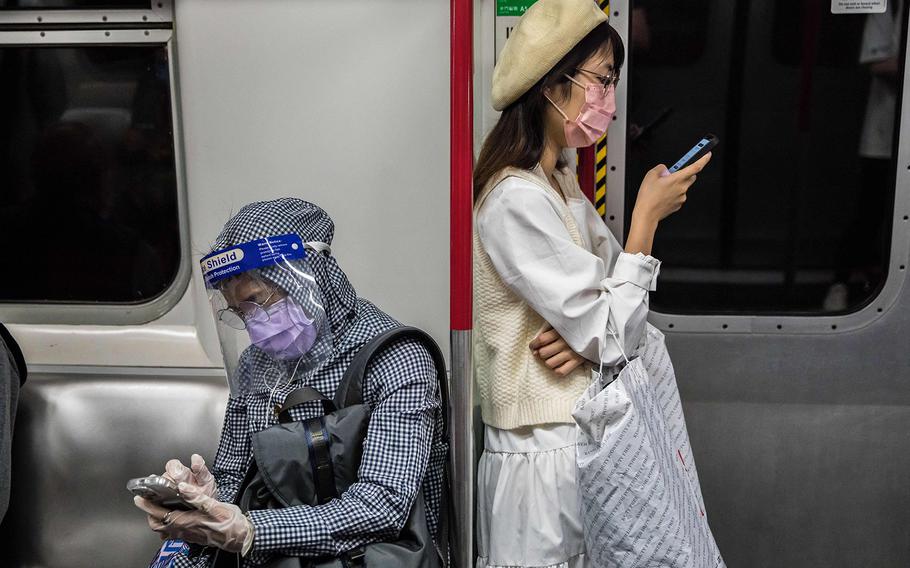
People wearing face masks as a preventive measure against the COVID-19 coronavirus commute on a train in Hong Kong on March 2, 2022. (Dale De La Rey, AFP via Getty Images/TNS)
Stars and Stripes is making stories on the coronavirus pandemic available free of charge. See more stories here. Sign up for our daily coronavirus newsletter here. Please support our journalism with a subscription.
(Tribune News Service) — Hong Kong reported a record of more than 55,000 daily new infections on Wednesday as the city’s spiraling outbreak sees thousands of residents flee while those remaining strip shelves of food and medicine.
The figure is up from 32,597 a day earlier. Health authorities also announced 117 deaths, mostly people from care facilities, and said there are 64 patients in critical condition in hospital.
The continued spike in cases comes amid growing chaos and confusion around the city’s plan to test the whole population of 7.4 million three times in March, with dueling local media reports about the length and strictness of the lockdown to occur while testing is conducted.
On Wednesday afternoon, after over a week out of the public eye, Chief Executive Carrie Lam sought to reassure residents during a television interview from a railroad yard, after the first train-load of goods from mainland China to the city arrived as part of a new program to stabilize import flows.
China will ensure Hong Kong has enough food and other supplies during the COVID outbreak, said Lam, urging residents to stop their panicked purchasing. There will also be unlimited supplies of medical equipment available, she said.
Lam acknowledged that there won’t be enough beds to isolate everyone found to be infected with the virus during the city-wide testing program, though she vowed to make the process as quick and comprehensive as possible. People will be able to get their needs met even during the mass testing effort, she said, ruling out a “wholesale” city lockdown, though she did not clarify how the mass testing would be conducted and when.
The information vacuum has exacerbated deteriorating conditions in Hong Kong as its outbreak becomes one of the deadliest in the world. The city’s loss of control is a real-world illustration of the limits of the COVID Zero strategy in the face of more transmissible variants like omicron.
The uncertainty about how residents will be treated, and rising case and death rates, led U.S. authorities to warn against travel to the city. The U.S. State Department raised its travel advisory to a Level 4 — Do Not Travel — because of COVID and related restrictions, while the Centers for Disease Control and Prevention bumped its travel alert two places to “high.”
The zero-tolerance approach to COVID-19 by Hong Kong and China “severely impacts travel and access to public services,” the U.S. Consulate General Hong Kong and Macau said in an email. “We especially want to note for families considering traveling to or residing in Hong Kong that in some cases, children in Hong Kong who test positive have been separated from their parents and kept in isolation until they meet local hospital discharge requirements.”
Local media reports have differed on the details of the upcoming lockdown, sowing confusion. HK01 reported Wednesday that there would be a four-day limited lockdown at the end of March, and Cable TV said the city will set a time limit for residents to buy groceries. Stories from Sing Tao Daily and the South China Morning Post a day earlier triggered panic-buying with details of a strict nine-day lockdown planned for the middle of March.
Many among the anxious population, which just two months ago were living in largely virus-free conditions, have had enough. There were 43,689 net departures from the city in the past two weeks, the most since the start of the pandemic, according to government data. In a bear case — where the COVID outbreak peaks late in the second quarter — Bank of America Corp. analysts estimate 2% to 3% of Hong Kong’s population could depart every month.
©2022 Bloomberg L.P.
Visit bloomberg.com.
Distributed by Tribune Content Agency, LLC.